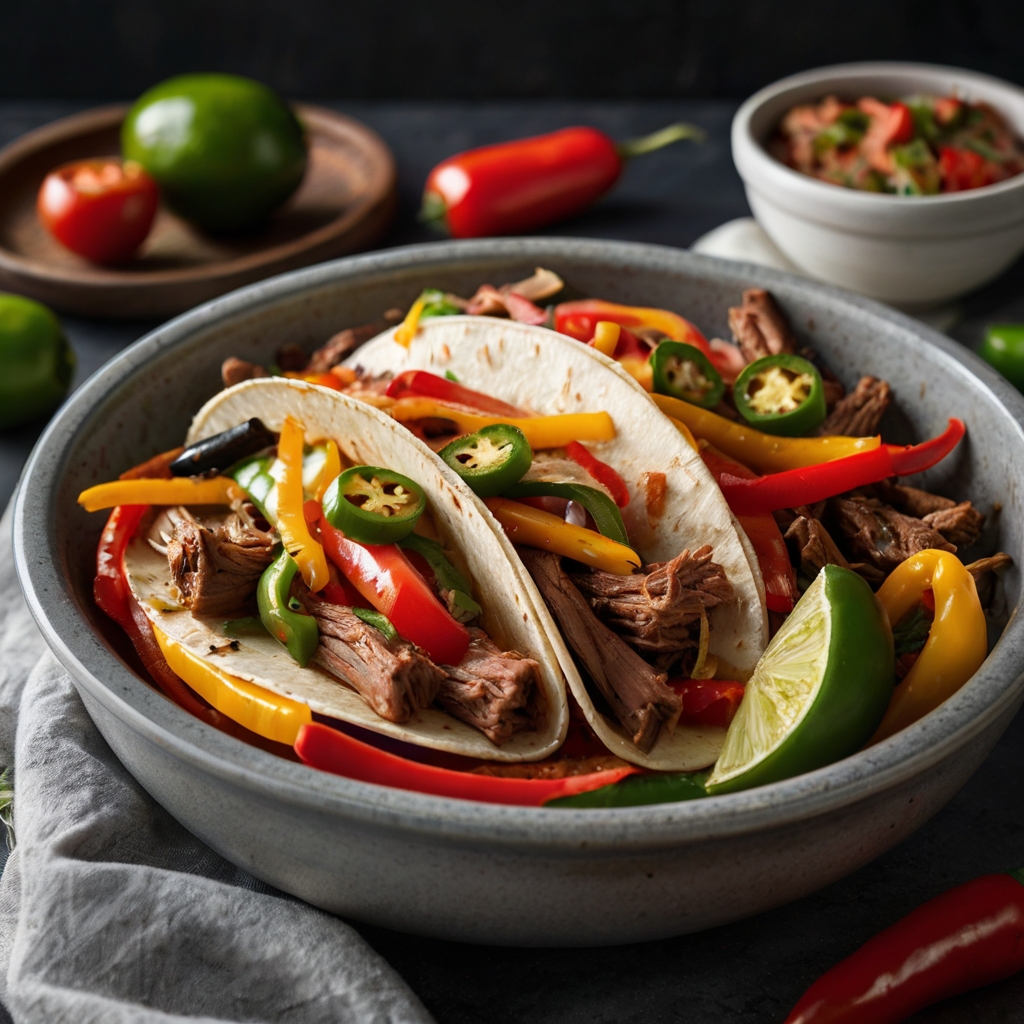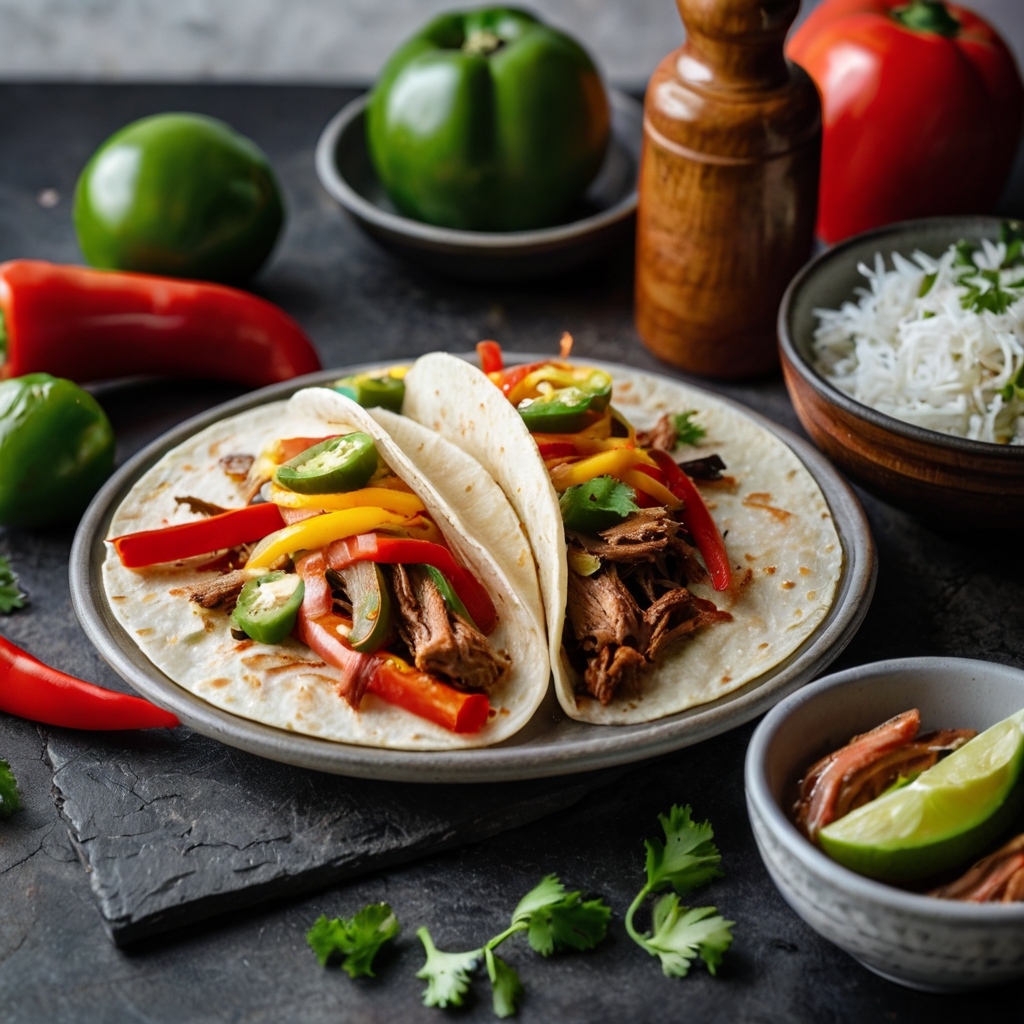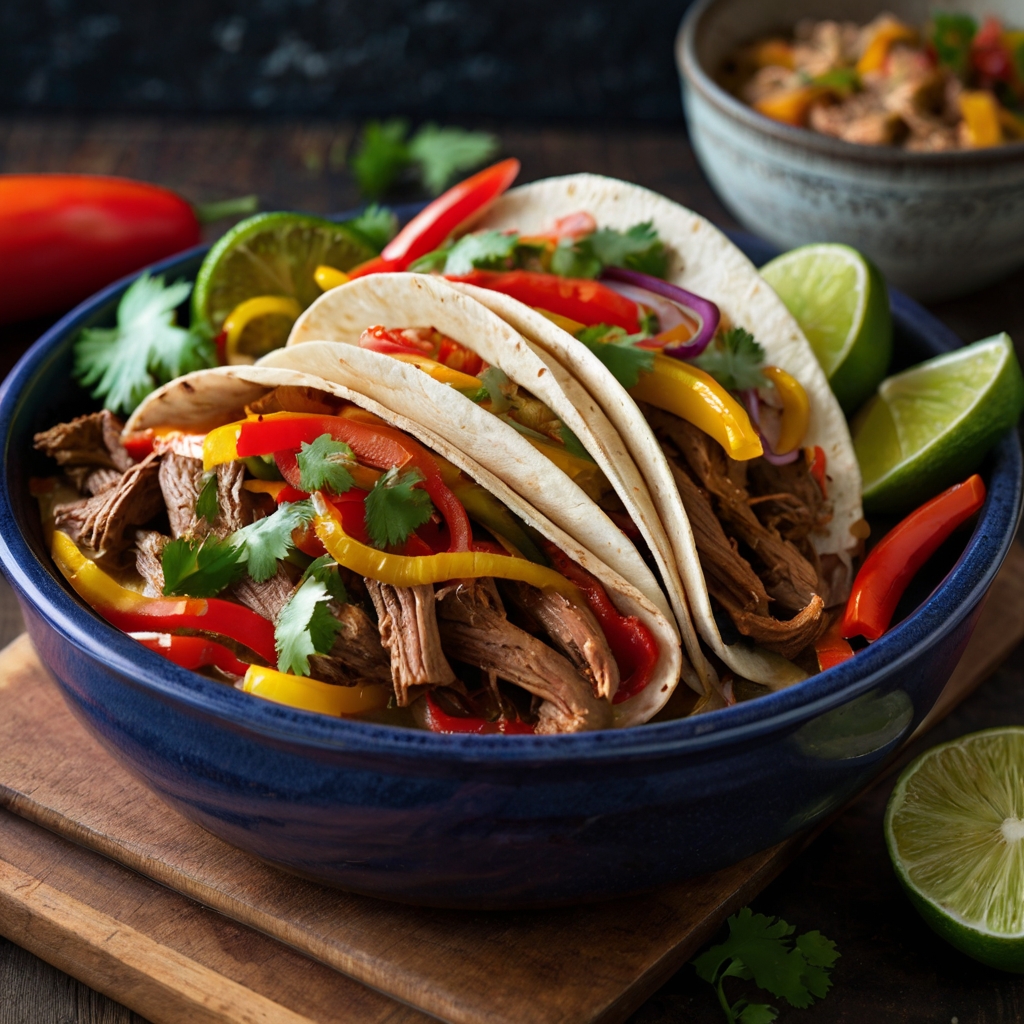Slow Cooker Fajitas: A Flavor-Packed, Hands-Off Fiesta

Hi, my name is Chef Marcus. I’ve spent over two decades in professional kitchens, from Tex-Mex food trucks in Austin to high-end Latin fusion restaurants in New York. And if there’s one comfort dish that always gets people excited around the dinner table, it’s fajitas — especially when they’ve been slow-cooked to perfection. Whether you’re a busy parent, a weekend meal-prepper, or just someone looking for maximum flavor with minimum effort, you’re going to love what I have to share.
Why Make Fajitas in a Slow Cooker?
Benefits of Slow Cooking for Fajitas

If you’ve only ever had fajitas sizzling fresh off a cast-iron skillet, let me tell you: the slow cooker version brings something entirely different to the table. With low and steady heat, you unlock deeper, richer flavors — and the meat becomes unbelievably tender, practically falling apart with a fork. It’s also the ultimate set-it-and-forget-it approach, which is perfect if you’re short on time or juggling a busy household.
For many of my clients doing weekly meal prep, slow cooker fajitas are a go-to because they require minimal monitoring. Prep it in the morning, and come home to a kitchen that smells like a street market in San Antonio.
How Fajitas Flavor Evolves over Time
Let’s talk texture — and why the slow cooker changes everything. As the meat simmers gently in its own juices along with peppers, onions, and spices, collagen in tougher cuts like flank or skirt steak breaks down into gelatin. That’s what gives the finished product a mouth-coating richness you won’t get from a quick pan sear.
The vegetables? They absorb the seasoning, soften just enough, and become part of a deeply flavorful, juicy mixture. If you add peppers late (which I’ll cover later), you keep a bit of that crunch — or you can let them melt in. Your call.
Chicken, Beef, or Veggie — What is Better?
In my kitchen, here’s how I break it down:
| Protein Type | Best Cut | Cook Time | Notes |
| Beef | Flank, skirt, or chuck | 6–8 hours (low) | Rich, deep flavor. Slice against the grain. |
| Chicken | Thighs or breasts | 4–6 hours (low) | Shreds beautifully. Thighs offer more moisture. |
| Veggie | Portobello, jackfruit | 3–4 hours (low) | Great meatless option, but reduce liquid. |
I personally love beef for the hearty, carnivorous feel. But for weeknight simplicity, boneless skinless chicken thighs are unbeatable. Vegetarian? Go bold with portobellos and smoky chipotle in adobo.
Ingredients for the Slow Cooker Fajitas
Essential Ingredients (Meat, Peppers, Onions, Seasonings)
Here’s your base shopping list. Keep it simple, keep it flavorful:
| Ingredient | Quantity | Notes |
| Meat (beef or chicken) | 2–2.5 lbs | Trimmed and sliced or whole (shred later) |
| Bell peppers | 3 (mixed colors) | Sliced into strips |
| Yellow onion | 1 large | Halved and sliced |
| Garlic cloves | 3 | Minced |
| Olive oil | 1–2 tbsp | For richness |
| Lime juice | 1–2 tbsp | Added at the end for freshness |
| Fajita seasoning | 2–3 tbsp | Homemade or store-bought (see below) |
Pro tip: If you’re short on time, use frozen sliced peppers and onions — just reduce added liquid slightly.
Homemade Fajita Seasoning Mix vs Store-Bought
Store-bought seasoning is fine in a pinch, but I always recommend mixing your own. Here’s my go-to blend — better flavor, no preservatives:
Chef Marcus’ Homemade Fajita Seasoning:
| Spice | Amount |
| Chili powder | 1 tbsp |
| Smoked paprika | 2 tsp |
| Ground cumin | 1 tsp |
| Garlic powder | 1 tsp |
| Onion powder | 1 tsp |
| Dried oregano | 1 tsp |
| Salt | 1 tsp |
| Black pepper | ½ tsp |
| Crushed red pepper (optional) | ¼ tsp |
This blend gives you that smoky, earthy backbone with just enough heat to lift the dish. Mix a double batch and store in an airtight jar — you’ll use it often.
Optional Add-Ins for fajitas (Garlic, Lime, Jalapeños)
Want to elevate your fajitas from good to unforgettable? Add:
- Fresh garlic — Always go fresh. Adds punch and aroma.
- Jalapeños or chipotle peppers — Brings depth and heat.
- Lime juice or zest — Brightens up the entire dish.
- Cilantro stems — Toss in a handful during cooking. Don’t knock it till you try it.
Low-Sodium and Clean-Eating Variations
If you’re watching sodium, skip store-bought seasoning and use my homemade blend — just reduce the salt and skip the broth or use low-sodium versions.
For clean eating:
- Use organic chicken or grass-fed beef
- Choose cold-pressed oils
- Skip added sugar or thickeners
Vegan and Gluten-Free Swaps
- Use jackfruit, tempeh, or portobello mushrooms as the protein
- Sub vegetable broth for any meat stock
- All seasonings listed above are naturally gluten-free, but check labels if buying pre-made mixes
- Wrap in gluten-free tortillas or lettuce cups
Slow Cooker Fajita Recipe
Quick Prep Tips fajitas for Busy Days
Let’s be real — weeknights are chaos. That’s why I designed this recipe to be meal-prep-friendly. You can slice your peppers and onions up to 3 days ahead and store them in an airtight container. You can also toss your meat in the seasoning mix the night before and refrigerate it, so all you have to do in the morning is dump and go.
Pro tip: Use slow cooker liners for the easiest cleanup of your life. Seriously. You’ll thank me later.
Layering Ingredients for Best Results
The order you layer ingredients in a slow cooker actually matters — especially with fajitas. Here’s the foolproof layering system I use:
- Sliced onions and half the peppers (bottom layer — they act as a flavor base and help prevent sticking).
- Seasoned meat (chicken or beef) — place on top of the veggie base.
- Garlic, seasoning mix, lime juice, and any broth or oil — pour evenly over meat.
- Remaining peppers (added later if you want some bite — more on that below).
This method ensures maximum flavor infusion and even cooking.
Cook Time: Low vs High Settings

Here’s your cheat sheet:
| Protein | Low Heat | High Heat |
| Chicken (thighs or breasts) | 4–6 hours | 2.5–3.5 hours |
| Beef (flank or skirt steak) | 6–8 hours | 3.5–4.5 hours |
| Veggies only (mushrooms, jackfruit) | 3–4 hours | 1.5–2.5 hours |
Rule of thumb: Low and slow gives you the best tenderness, but if you’re pressed for time, high heat still gets the job done.
When to Add Bell Peppers for Ideal Texture
If you like soft, melt-in-your-mouth peppers, add them in at the beginning with the onions.
But if you prefer a bit of crunch and vibrant color, wait and add the rest of the peppers during the last hour of cooking. They’ll steam just enough to stay crisp-tender and not turn to mush.
I often do a mix: half in the beginning, half near the end — best of both worlds.
How to Shred or Slice After Cooking
After cooking, you have options:
- Chicken: Use two forks to shred it right in the pot. It’ll soak up all that flavorful juice.
- Beef: Let it rest for 5–10 minutes, then slice against the grain into thin strips.
- Veggies: No cutting needed. Just stir and serve.
If the mixture seems too wet, remove the lid for the last 30 minutes of cooking, or strain a bit of liquid before serving. Or better yet, save that liquid for rice or quinoa. Liquid gold, my friend.
Flavor Variations and Regional Twists
You know me — I love giving classic recipes a twist. Once you’ve mastered the base, here are four ways to play with flavor and make your fajitas shine:
Tex-Mex Style with Extra Heat
If you’re cooking for spice lovers, this one’s for you. Start with my base recipe and amp it up:
- Add chipotle peppers in adobo sauce (1–2 tablespoons)
- Toss in a few sliced jalapeños or serranos
- Stir in crushed red pepper flakes with the seasoning
- Finish with a splash of hot sauce before serving
Pro move: Serve with spicy queso or pepper jack cheese on the side.
Citrus-Lime Chicken Fajitas
Bright, fresh, and perfect for summer — or just pretending it’s summer.
- Use boneless skinless chicken thighs
- Add zest and juice of 1 orange + 1 lime
- Toss in cilantro stems during cooking, and chopped leaves before serving
- Skip heavy seasonings in favor of light chili powder and garlic
This version pairs beautifully with avocado slices, cotija cheese, and lettuce wraps.
Chipotle BBQ Fajitas with a Smoky Kick
A little Texan BBQ meets Mexican street food.
- Mix 2 tablespoons of BBQ sauce into the seasoning blend
- Use smoked paprika instead of regular
- Add a splash of apple cider vinegar
- Stir in a dash of liquid smoke (if desired)
Serve with grilled corn tortillas, pickled red onions, and a cold Mexican lager.
Vegetarian Fajitas with Mushrooms and Zucchini
This is one of my favorites when I’m cooking plant-based for clients.
- Swap meat for portobello mushrooms, zucchini, and red onion
- Cut back on liquid — veggies release a lot of moisture
- Add a few slices of poblano or smoked tofu for depth
- Finish with lime juice and a dollop of guac
Pair with brown rice, a black bean salad, or stuff into grilled flatbread for a killer veggie wrap.
What to Serve with Slow Cooker Fajitas
Classic Sides: Rice, Beans, and Tortillas
You can’t go wrong with the staples. When I cater events or serve family-style meals, I always pair slow cooker fajitas with:
- Mexican rice or cilantro-lime rice
- Refried beans, black beans, or charro beans
- Warm flour or corn tortillas — wrapped in foil and kept warm in the oven
If you want that restaurant-style experience, serve the fajitas sizzling on a cast iron skillet straight from the slow cooker. Adds flair and keeps things hot.
Fresh Toppings and Garnishes (Avocado, Salsa, Sour Cream)
This is where the magic happens — toppings bring freshness, color, and contrast to every bite. Here are my go-to garnishes:
| Topping | What It Adds |
| Sliced avocado | Creamy richness |
| Fresh cilantro | Herbal brightness |
| Lime wedges | Tangy acidity |
| Sour cream or crema | Coolness + contrast |
| Shredded cheese | Melt + saltiness |
| Pico de gallo or salsa | Juicy freshness |
| Pickled onions | Sharp, sweet crunch |
Chef’s Tip: Serve everything in small bowls so guests can build their own perfect bite.
Low-Carb and Paleo Serving Options (Lettuce Wraps, Cauliflower Rice)
Feeding folks with dietary goals? No problem. Here are some low-carb and clean-eating swaps I use often:
- Lettuce wraps: Use romaine or butter lettuce for handheld fajitas.
- Cauliflower rice: Sautéed with lime and garlic, it’s a great sub for rice.
- Grilled portobello caps: Stuff them with fajita filling for a hearty option.
- Zoodles or veggie noodles: Great base for fajita bowls.
I’ve even served fajitas over mashed avocado with chopped greens for a fajita salad bowl. It works.
Storage, Leftovers, and Meal Prep Tips
How to Store Cooked Fajita Filling
Once cooled, transfer your leftovers into airtight containers. Store meat and vegetables separately from toppings and tortillas to prevent sogginess.
| Storage Method | How Long It Lasts |
| Fridge | Up to 4 days |
| Freezer | Up to 3 months |
Label and date everything. Future-you will appreciate it.
Best Way to Reheat Without Drying It Out
The key is moisture.
- Microwave: Add a splash of broth or water, cover loosely, and microwave in 1-minute intervals.
- Skillet: Heat over medium with a touch of oil or liquid. Stir often.
- Oven: Cover with foil and heat at 300°F (150°C) until warm.
Avoid reheating dry. A spoonful of reserved cooking liquid goes a long way.
Freezer-Friendly Meal Prep Instructions
Want to prep fajitas in advance? I do this for client meal plans all the time. Here’s how:
- Slice all veggies and season meat.
- Place everything (uncooked) into a large freezer-safe bag.
- Squeeze out air, label with the date and instructions.
- Freeze flat for easy storage.
Make-Ahead Freezer Fajita Packs
| Pack Contents | Notes |
| Sliced peppers & onions | Freeze raw, not cooked |
| Seasoned chicken or beef | Use freezer-safe bags |
| Lime juice & garlic | Add to the bag with meat |
Cooking from frozen: Thaw overnight in the fridge, then dump into the slow cooker and follow the regular cooking instructions.
Common Mistakes to Avoid with Slow Cooker Fajitas
Why Are My Fajitas Mushy or Watery?
This usually happens for one of three reasons:
- Too much liquid — slow cookers create their own moisture, so go easy on broth or sauces.
- Peppers added too early — they break down fast (see below).
- Lid left on after cooking — steam has nowhere to go.
Fix: Uncover during the last 30 minutes to evaporate excess moisture, or strain before serving.
Overcooking the Peppers — When to Add Them
Peppers are delicate. I’ve tested this dozens of times in my career — the sweet spot is:
- Add half at the beginning (for flavor)
- Add the rest during the last hour (for texture)
This gives you depth and crunch — the best of both worlds.
How to Keep the Meat Flavorful and Not Bland

A few ways to level up the flavor:
- Season the meat directly, not just the veggies.
- Use bold spices like cumin, chili powder, smoked paprika.
- Don’t skip acid — lime juice or vinegar brightens the whole dish.
- Let the meat rest before slicing to keep juices locked in.
Bland fajitas are usually under-seasoned or overcooked. Taste as you go. Trust your instincts.
15+ FAQ about Fajitas
1. Can I use frozen meat in the slow cooker for fajitas?
I don’t recommend it. Always thaw meat before slow cooking to ensure even cooking and food safety.
2. Do I need to sear the meat before adding it to the slow cooker?
You don’t have to, but I often do. A quick sear adds depth of flavor and helps lock in juices.
3. What cut of beef works best for slow cooker fajitas?
I like flank steak or skirt steak. They’re flavorful and shred beautifully after slow cooking.
4. Can I use chicken thighs instead of breasts?
Absolutely. Thighs stay juicier and are more forgiving in a slow cooker.
5. When should I add bell peppers?
Add half at the beginning and the other half in the last 45 minutes for better texture.
6. Can I cook everything on high to save time?
You can, but I prefer low for 6–7 hours. The flavors meld better and meat stays tender.
7. How do I keep fajitas from getting watery?
Go easy on liquids. Meat and veggies release plenty of moisture on their own.
8. Do I need to stir the fajitas during cooking?
Not really. Just layer well. But I do give them a gentle stir at the halfway mark.
9. Can I use pre-cut frozen peppers and onions?
You can, but they’ll be much softer. I recommend fresh for the best texture.
10. Is homemade fajita seasoning better than store-bought?
In my kitchen — always. It takes 2 minutes to mix and tastes way fresher.
11. How spicy should fajitas be?
That’s personal. I give a mild base, then serve with hot sauce or jalapeños on the side.
12. How can I make this recipe keto-friendly?
Skip the tortillas, use lettuce wraps, and reduce the onions a bit.
13. What’s the best way to reheat leftovers?
Reheat on the stovetop with a splash of broth. It keeps everything juicy.
14. Can I cook everything the night before and reheat the next day?
You sure can. Flavors develop overnight, and it reheats beautifully.
15. Do I need to add oil or butter to the slow cooker?
Not necessary. The meat and veggies release enough moisture on their own.